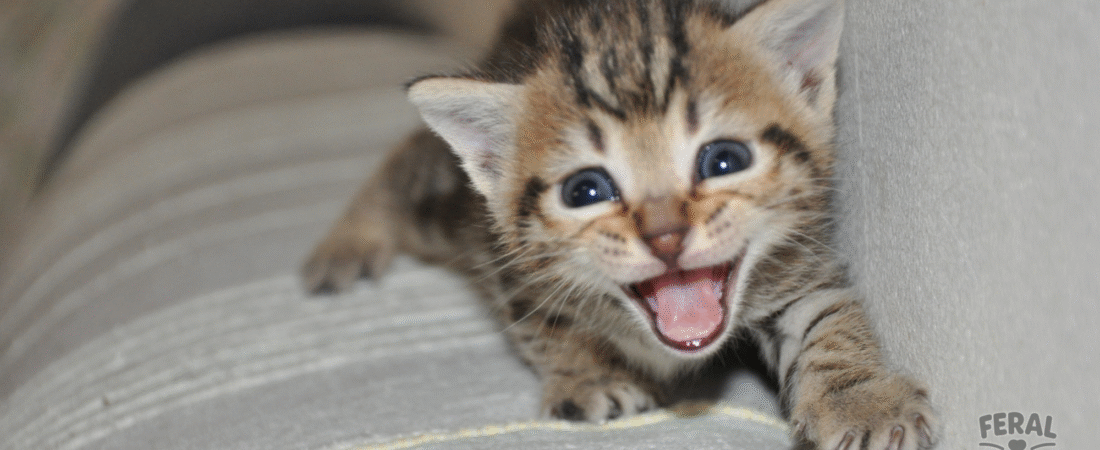📌 Why Cats Meow (Mostly for Us)

The meow is arguably the most iconic cat sound, but here’s a fun fact: adult cats rarely meow at each other. They primarily developed this vocalization to communicate with humans.
- Kitten talk: Kittens meow to their mothers for attention, food, or comfort.
- Adult cat talk: As they grow, cats learn that meowing gets a reaction from their giant, bipedal housemates (us!).
- Why it’s quirky: Your cat has a whole vocabulary just for you.
👉 Decoding these meows helps you understand what your cat wants, needs, or is trying to tell you.
🦠 The Cat’s Vocal Dictionary: What Each Sound Means
1. The Standard Meow (Mid-Pitched, Single Sound) 💬
- Meaning: A general greeting, a request for attention, or a simple “hello.”
- Context: Often heard when you walk in the door, or when your cat wants you to acknowledge their presence.
2. The Demanding Meow (Loud, Repetitive, Urgent) 📢
- Meaning: “Feed me NOW!” “Let me in/out!” “Play with me, I’m bored!”
- Context: Often accompanied by rubbing against your legs, staring at the food bowl, or pacing by a door. This is the “solicitation meow” we discussed earlier.
3. The Chirp or Trill (Bird-like, Rolling R Sound) 🐦
- Meaning: A friendly greeting, an invitation to follow, or a way to get your attention.
- Context: Mother cats use this to call their kittens. Your cat might use it to lead you to their food bowl or a favorite toy.
4. The Yowl or Howl (Long, Drawn-Out, Low-Pitched) 🐺
- Meaning: Distress, pain, seeking a mate (in unspayed/unneutered cats), or territorial warning.
- Context: Can be heard during fights, when a cat is lost, or when a female cat is in heat. In older cats, it can signal disorientation or cognitive decline.
5. The Hiss (Sharp, Sibilant Sound) 🐍
- Meaning: Fear, aggression, or a warning to back off.
- Context: A defensive sound when a cat feels threatened and is ready to strike if necessary. Often accompanied by an arched back and puffed fur.
6. The Growl (Low, Rumbling Sound) 🐻
- Meaning: Aggression, anger, or a warning.
- Context: Usually heard during fights, when a cat is protecting resources (food, toys), or when feeling cornered.
7. The Chatter (Rapid Jaw Movement, Silent or Soft Sound) 😬
- Meaning: Frustration or excitement, often related to hunting.
- Context: When a cat sees prey (bird, squirrel) outside a window and can’t reach it. It’s an instinctual “practice bite” or a sign of intense predatory focus.
🚨 When Vocalizations Are a Red Flag
- Sudden increase in meowing/yowling: Could indicate pain, illness (e.g., hyperthyroidism, kidney disease), stress, or cognitive dysfunction in older cats.
- Excessive howling at night: Common in senior cats with dementia or those seeking attention.
- Constant hissing/growling: Points to severe stress, fear, or aggression that needs professional intervention.
👉 Any sudden, drastic change in your cat’s vocal habits warrants a vet visit.
🌿 Holistic & Practical Communication Tips
- Listen to the context: A meow by the food bowl means something different than a meow at 3 a.m.
- Respond appropriately:
- Happy meow: Respond with a gentle voice, petting, or a slow blink.
- Demanding meow: Don’t always give in immediately. Wait for a moment of quiet before fulfilling the request to avoid reinforcing constant meowing.
- Distress meow: Investigate immediately.
- Enrichment: Boredom often leads to excessive meowing. Provide interactive toys, puzzle feeders, and playtime.
- Routine: Cats thrive on predictability. Consistent feeding and play times can reduce anxiety-driven vocalizations.
❓ FAQs
Q1: Why does my cat only meow at me and not other people?
Cats often develop a unique vocal “language” with their primary caregiver. It’s a sign of a special bond and trust.
Q2: My cat meows constantly. How can I make them stop?
First, rule out medical issues with a vet. Then, ensure they have enough enrichment and try to avoid reinforcing constant meowing with immediate rewards.
Q3: Why do cats purr and meow at the same time?
This often happens when they are extremely happy and seeking attention or food. It’s a combination of contentment and a request.
Q4: Do different breeds meow differently?
Yes! Siamese cats are famous for their loud, insistent, almost “talking” meows, while breeds like Maine Coons often have softer chirps and trills.
💡 Final Thoughts
Your cat’s meows are a personalized soundtrack of their needs, moods, and desires, crafted just for you.
✅ Key takeaway: By paying attention to the pitch, frequency, and context of their vocalizations, you can become fluent in your cat’s unique language and build an even stronger bond.

